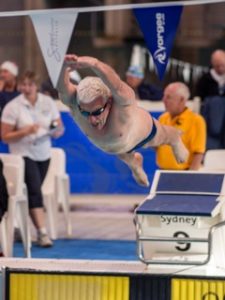Swimming in a competition can be daunting, but it needn’t be. You are among friends and Masters Swimming encourages you to have a go, but most importantly, to have fun.

Are you new to Masters swimming competitions?
This article assumes that you know the rules applicable to the stroke(s) you are swimming so they will not be covered here.
Recent meets have included a lot of swimmers who were participating in their first Masters competition. Most swimmers seemed to have been briefed appropriately about the procedures involved but there were some who seemed unsure so this article covers those procedures from the time entry is considered right through until the swimmer is out of the water after completing an event.
The first thing you need to think about is what time should you put on the entry form for each event. For those not used to competing, this may not be of great concern but it can make a great deal of difference to the meet organisers and other competitors. At Masters meets, the competitors in each event are sorted by entry time so that swimmers in each heat swim roughly about the same time. A competitor who puts in an entry time which is much faster than they can actually swim ends up finishing the heat on their own which delays the rest of the day’s program. It is particularly important for the longer distance events where an incorrect time can result in a swimmer being several minutes behind the rest of the field which delays the whole meet by those several minutes. At the other end of the scale, putting in a really slow time so that you can easily win a heat won’t help overall because the final results are based solely on times swum within each age group. If you don’t have any history of times, work with your coach or a fellow club member to do some trials and try to get a reasonable idea of how fast you might swim in each event.
 Another thing you need to think about before the meet is what you are going to wear, both during the race and before events. Since 2010 there have been quite tight rules regarding swimwear and swimmers should make sure they understand those rules. MSA has adopted the FINA swimsuit rules and there is a summary document about those rules on the MSA web site. Some of the key aspects include wearing only one swimsuit which must be made of textile material and have no fasteners. Taping of the body, jewellery and watches are prohibited although we do accept normal rings and bangles etc. which cannot be removed without damage. Make sure that your cap and goggles fit neatly and are tight enough to stay in place when you dive in at the start.
Another thing you need to think about before the meet is what you are going to wear, both during the race and before events. Since 2010 there have been quite tight rules regarding swimwear and swimmers should make sure they understand those rules. MSA has adopted the FINA swimsuit rules and there is a summary document about those rules on the MSA web site. Some of the key aspects include wearing only one swimsuit which must be made of textile material and have no fasteners. Taping of the body, jewellery and watches are prohibited although we do accept normal rings and bangles etc. which cannot be removed without damage. Make sure that your cap and goggles fit neatly and are tight enough to stay in place when you dive in at the start.
At the pool, swimmers will be marshalled for each event i.e. the swimmers for each heat will be assembled together and taken out to the starting end as a group. The procedures for marshalling will vary between pools and meets so you will need to determine where you have to go and how far ahead of your event/heat you need to be there. Generally there will be PA announcements calling for groups of heats and possibly displays on an electronic scoreboard if one is available at the pool.
This is where what you wear before the race also needs consideration. Once you have warmed up for an event, you will want to keep warm while you wait for your event. You will need something which will keep you and your feet warm enough both in the stands and in the marshalling room. The temperature in both of those places may be very different from the pool deck so be prepared. This outer clothing and footwear will also need to be able to be removed quickly once you are on the pool deck so that you do not delay the start.
From the marshalling area swimmers for each heat will move out behind the blocks as a group where they will position themselves behind the lane they are allocated for the heat. The Check Starter should then check off the swimmers against the program to ensure that they are in the right lane for their heat. The preceding heat may still be standing behind the blocks ready for their start so take care not to get mixed up with that heat. Mix ups between heats most often happens when there is an empty lane in one heat and an overly keen swimmer in the next heat steps forward prematurely so be sure to stay with the correct heat.
Once the preceding heat has started your next move will be stepping up behind the starting block ready to swim i.e. cap & goggles in place and outer clothing removed. How long you have to get ready will depend on the length of the event. For single lap sprints you will have very little time so you will need to be getting ready from the time your heat arrives behind the blocks. For longer events, particularly distance events like 400 to 1500m events, you should have a bit more time. It is your responsibility to be ready to swim as soon as the previous heat finishes so make sure you allow enough time to get your outer garments off and cap & goggles in place. The referee has the power to disqualify swimmers who delay the start because they are not ready.
What happens when the preceding heat finishes will depend on whether the meet is being run as conventional starts or ‘starting over the top’.
If it is conventional starts, the referee will give two short blasts on the whistle to indicate to the swimmers in the water that they should get out of the pool. The two shorts blasts are a signal to swimmers in the water, not to those about to start. Once all swimmers are out of the water and timekeepers are ready, the referee will give one long whistle to indicate to the swimmers to step up to their starting positions.
If it is ‘starting over the top’, those in the water should move to the side of their lane after they have finished and hang on to the lane rope about a metre from the end of the pool i.e. well clear of any automatic timing pads. When the timekeepers are ready, the referee will give one long whistle to indicate to the swimmers to step up to their starting positions.
That one long whistle is the beginning of the starting procedure, whether for a conventional start ‘or starting over the top’. On that whistle swimmers should immediately step on to their starting position – on the block, on the pool edge or in the water. Any swimmers starting in the water should jump into the water on that signal and move straight to their starting position with one hand holding the starting grip or pool wall. It is not necessary to notify anybody if starting in the water – just jump in. Swimmers starting on the block or from the pool edge should have at least one foot at the front of block or the edge of the pool i.e. where they will be for the start. By the time the referee gives that signal swimmers must be ready to start. It is too late to be putting on caps or goggles. Anyone not ready at that point is likely to be disqualified for delaying the start. Next, the starter will say ‘take your marks’ and swimmers should then assume their starting position and hold steady until the starting signal is given.
The race is then underway and it is just a matter of time until you find out how well you went. How you swim it is something you need to plan with your coach but there is something to consider for the finish: if automated timing is in use, how you touch the wall can be significant. If you hit the top of the pad for example, you may not put sufficient pressure on the pad for it to record initially so the best technique is to try for a firm touch on the front of the pad just below the water line.
Once you have finished your race in an individual event you should remain in the water until directed to get out of the pool. The directive to get out will be the two short blasts of the whistle unless the meet is being run as ‘starting over the top’. In that case, you get out of the pool as soon as the next heat has started. You should get out via the side of the pool. Never climb over timing touch pads to get out of the pool.
All that remains is to check your result. The results of each event will be posted in a convenient location around the pool shortly after the last heat is completed for the event. If you think there has been an error in your result, go to the recording area and ask an official.
If you unsure at any stage what the correct procedure to follow is, please ask one of the officials. It is best to find out the correct rule before you race, rather than risk disqualification.
John Marshall
MSV Technical Director

